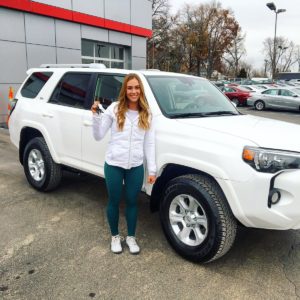There are a few moments in life that you’ll remember forever. The first car purchase is usually one of them. With some careful thought you can make this experience even better. I’ve listed 7 steps to making your first car purchase a good one.
- Determine What You Really Need
Really give some consideration to how you will use your car. How much driving are you going to do? What are the weather conditions? How many passengers will be in the car?
2. Determine Your Budget
Be realistic about your budget. Owning a car is more than the purchase price. After your purchase you will owe taxes and license fees. These can range 8%-10% of the cost of your car. You’ll need money for insurance, maintenance, gas, etc. Learn more about the true cost of owning a car.
Determine where the money will come from. Have you saved the money? Is someone helping you buy your car? Are you financing? Can you lease a car? All of these are options that you’ll need to understand.
3. Explore Your Options
Shopping for a car is far easier today that any time in the past. The internet has made it simple to explore your options.
Craigslist or other non-dealer sites- This can be the perfect way to find the car that meets your budget, quality and price. However, you need to be careful. There are a lot of less than honorable sellers on Craigslist. With a little extra effort you can buy the perfect car this way.
Buying from a car dealer that you know and trust is a good option. Often car dealers have gone through the car and repaired and defects and made sure the car is safe and reliable. You will also find that most dealers will supply you with a Carfax report that will tell you the history of the car. Carfax will list things like accidents, mileage, owners, etc.
Consider buying from someone you know. Many people get there first car from a parent, grandparent, family friend etc. You will often find that this is the best deal. You know the cars history and will likely get a better price.
4. Saftety Options
You will find this one of the most difficult areas. We all want to protect our loved ones and keep them safe, but there are likely trade off’s that you will have to make between the latest technology and budget. Some of these safety features should really be considered before a purchase is made.
1) Airbags- Airbags deploy when in an accident and protect the by slowing the inertia of movement caused by the accident. Most cars come with a drivers airbag, but is this enough for you. Do you want a passangers airbag. Do you need side airbags to provide security in side impact. My suggestion is at least a airbag for the front driver and passanger.
2) Anti-Lock Brakes- Antilock brakes keep the wheels from locking and sliding when you hit the brakes hard. The ABS system uses sensors on the wheels to surge the brakes to prevent locking and skidding. An ABS system will use sensors on each wheel to pulse the braking system to each wheel during hard braking in order to prevent locking the wheels. This safety feature will help keep you in control, even when you have to hit the brakes hard. ABS will help you maintain control of your car when you need to deploy your brakes quickly.
3) Electronic Stability Control- All cars after 2012 have been equipped with electronic stability control. This system uses sensors to prevent sliding and skidding when traction is lost. The system works by applying brakes to one or more wheels to regain traction.
4) Traction Control- Traction control limits the slip of the wheels when accelerating. You’ll maintain solid traction on wet and slippery surfaces. Traction control usually works along with antilock brakes to keep you from sliding and in control of the vehicle.
4. Research The Reliability and Maintenance
One of the advantages of buying a used car is there is a lot of information out there on the reliability and maintenance needs of every car.
Once you have a short list of cars go onto Consumer Reports or a site like it and research that year, make and model reliability history. This is important to keep you from buying a car that will eat up all your money in maintenance.
5. Take a Test Drive
When you are down to a few cars that might fit your needs and budget, take them for a test drive. Most people don’t have a plan when test driving. You should have an organized plan and a note pad to take notes about what you liked and didn’t about each car.
6. Run Vehicle History Report
There are companies that provide the history of your vehile for a fee. You will see items like accident history, ownership history, mileage reported etc. Carfax is one of the better known, more reliable sources.
7. Have a Mechanic Review
When it’s your first car and the budget is tight, it’s even more important to have a mechanic look at your potential purchase and give it a clean bill of health. It may be a good idea to also take the car by a local body shop to make sure its safe and sound.
If you are in Northern California stop by Collision Pros in Auburn, Chico, Paradise, Red Bluff or Woodland. We are more than happy to give your car a quick visual look and give you our opinion on any body repair that has been done.
